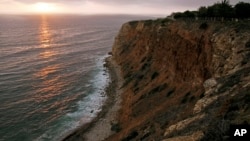It has been more than three years since the Fukushima nuclear plant accident resulted in a spill of millions of gallons of radioactive cooling water into the Pacific. Oceanographers projected it could take until this year for highly diluted traces of that spill to cross the ocean and reach the West Coast of North America. Radiation experts do not believe there is cause for alarm on American shores, but some coastal residents are stepping forward to pay for seawater testing just to be sure.
The presence or absence of Fukushima radiation in the water can hardly be more personal than it is for open water swimmer Wayne Kinslow of Seattle.
Testing the waters
"I just love the water. I go out, it is great exercise," said Kinslow. He swims about 20 minutes per day in chilly Puget Sound. So he willingly paid more than $500 for an independent water test. It did not detect any radiation from the nuclear plant.
"This was something that was really important to me because I am out there every day and I do not really want to die. So it is best to test the water and this is my chance. As soon as we got an opportunity, I just threw all my money at it for the first sample," he explained.
Kinslow is not the only one willing to pay big bucks for reassurance. High school art teacher Terry Waldron is raising money to test the waters near her family’s property in Newport, Oregon. "For a while, I thought about not eating fish. I cannot do that," she said. "But I was so concerned because I could not find information. I do eat fish, I do. But I still want that test done."
Waldron and Kinslow signed on to a crowd-funded radiation monitoring project called Our Radioactive Ocean. Managed by the Woods Hole Oceanographic Institute, it is collecting donations for testing at about 30 sites from California to Alaska.
Waldron and Kinslow say it is a lot of work and slow going to get others to contribute to this cause. That might have something to do with the fact that scientists and government agencies have been consistent in saying not to worry.
No indication of excessive radiation
In their monitoring, scientists look for the nuclear "fingerprint" of the Fukushima reactor, a combination of two isotopes of cesium.
"With the samples that we have taken along the West Coast, we do not see anything of concern. We do not expect to see anything," said Kathy Higley. Higley is professor of Radiation Health Physics at Oregon State University.
"It has diluted. It has decayed. It has dispersed. My husband and I take our kids to the coast all the time. We are not at all concerned about it. We eat seafood. We are not concerned about it," she added.
She said graduate students in her department are looking for Fukushima radiation, but not out of fear, rather out of academic and scientific interest. Isotopes released in the accident can be used as tracers to study ocean circulation and fish migration. This summer, one of Higley's students collected seawater samples and various fish on a research cruise off the Washington state and Oregon coasts. Delvan Neville is now analyzing them.
The samples go into a really, really sensitive detector covered in lead bricks. They have to sit inside the chamber for days to generate a result.
"It takes a long time to count it - one, because there is so little activity present. Even in the worst case model, there may be just a few Becquerels [measure of radioactivity] at most of cesium 137 on the detector," Neville stated.
Normal levels
For perspective, Neville said it helps to remember we are surrounded by low levels of natural radiation. "Several seconds in a stuffy basement was a larger dose than consuming a year's worth of albacore [tuna]. People are not aware of all the things around them that are radioactive," she said. "They do not consider themselves radioactive."
State public health agencies are also testing seawater for Fukushima contamination. Oregon results show nothing abnormal. Washington's latest results are pending. But it seems these efforts have not fully penetrated the public consciousness.
Enough people called marine chemist Ken Buesseler at the Woods Hole Oceanographic Institute seeking assurances that he started a citizen science testing program. That is the Our Radioactive Ocean project, which the swimmer and the art teacher we heard from earlier donated to.
"Given this concern and the numerous requests for information, I just decided if we could do this with crowd-funding, we could do this quickly and get people the information they want and basically let them select their beach - their favorite site - for analysis," stated Buesseler.
Another project uses seaweed as a radiation detector. Kelp Watch has expanded from its genesis at several California universities to include sampling for cesium off the Washington coast and Canada’s Vancouver Island. Brown seaweeds are known to concentrate cesium, strontium and iodine into their tissues, but all of the kelp fronds processed to date showed no signs of Fukushima radiation.









